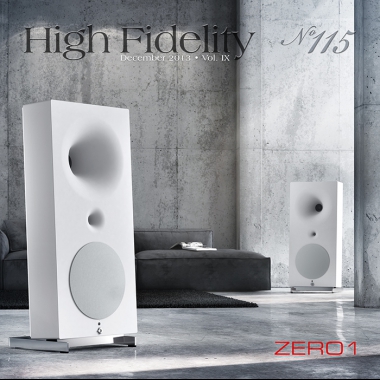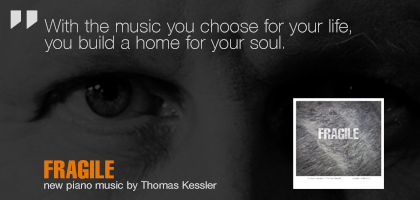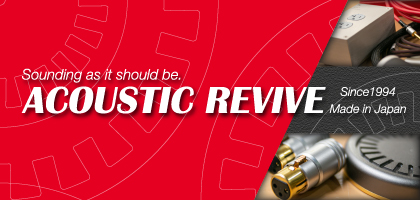No. 259 December 2025
- COVER REVIEW: LUMEN WHITE Altai ⸜ loudspeakers » AUSTRIA
- COVERAGE ⸜ audio show: HIGH FIDELITY on Audio Video Show 2025. A few worlds about time… » POLAND
- REVIEW: ACOUSTIC REVIVE Absolute Power Cord-K ⸜ power cable AC » JAPAN
- REVIEW: ANCIENT AUDIO Lektor 30th Anniversary ⸜ CD player » POLAND
- REVIEW: HAIKU-AUDIO Sol2 Pro ⸜ integrated amplifier » POLAND
- REVIEW: NORSE AUDIO X1 & X5 ⸜ power amplifier • stereo & power supply DC » SWEDEN
- REVIEW: SME Model 35 + Model Vi ⸜ turntable + tonearm » GREAT BRITAIN
- REVIEW: TiGLON MZ-Grande ⸜ anti-vibration feet » JAPAN
- REVIEW: THUNDER MELODY Ground Hub Black Edition ⸜ anti-vibration platform & ground unit » POLAND
- REVIEW: WK AUDIO TheRay Basic ⸜ analogue interconnect RCA » POLAND


|

|
|
TRANSPORT, ALSO KNOWN AS THE DRIVE
From the series: “Audiophile – that sounds proud” 

Initially, it all seemed so distant, practically unreal. On the 24th of November, 2009, Linn Audio published a shocking statement about ending the production of CD players and fully moving over to file players. The online store of the twin company Linn Records, currently one of the best sources for files with classical music (Digital streaming marks the end of an era for Linn CD players, Tuesday, November 24, 2009, see HERE), was improved and enlarged exactly for this purpose. Most household electronics manufacturers that specialize in audio components were rolling their eyes in disbelief, while scratching their head desperately trying to figure out what happened and where they fu..ed up. A paradigm change is happening right before our eyes. It does not only concern a different channel of music distribution and sales, not even the rights to the music bought in this way, but is about a complete transformation of how we go about listening to musical material, which is perfectly demonstrated in Mr. Witek Kamiński’s article “Seeing” music – a simple history about the eyes of the ears and a few other organs responsible for hearing. 
Philips CD Pro-2M The last of the great (except the CEC) What do I base my opinion on? On the fact that there goes one of the last, if not the very last, frontiers of “clean” high-end audio: Philips ended the production of the CD Pro-2M drive. In other words – the mechanism which was used by the majority of high-end manufacturers in their CD players. For example: Audio Research (CD-9; see HERE), Ayon Audio (CD-5, CD-T; see HERE), Ancient Audio (the Lektor series, see HERE), Jadis (Calliope; see the review of the JD1 MkII HERE), Metronome Technologie (Kalista Ultimate SE; see the review of the CD One T HERE http://highfidelity.pl/@main-123&lang=en ), MOON http://www.simaudio.com , LOIT (Passeri, see HERE), Reimyo (CDT-777; read HERE), Vitus Audio (Signature SCD-010; see HERE) and many, many more. 
Closing this chapter of the Dutch company history is symbolic, because it means the end of an available-to-all drive of this class, designed specifically for the needs of the Compact Disc format (the history of the drive and a description of all of its versions, reaching back to the CDM12, can be found HERE). This way, the only player left on the battlefield will be Japanese C.E.C. with its belt-drive, which is not, however, manufactured as OEM, and Burmester with its own variation. Paradoxically, the Philips was outlived by CD drives from the lower and middle price range – OEM versions, once produced by Sony and now used in CD players from Cambridge Audio, but also proprietary drives from Cyrus and Naim. The thing is that they’ve all been experimenting with file players for years, so it’s just a transitional phase. 
Compact Disc players will, obviously, remain in production for a few – maybe even dozen – years. The fastest-evolving element of their design will be the DAC section, and these changes will be forced by the PC Audio market and the one related to file players. You shouldn’t have any illusions as to the CD drive mechanism. It will not be developed and, what’s more, I am sure it will be more and more neglected.

Increasing number of high-end manufacturers will reach for DVD-ROM and even BD-ROM mechanisms, among others. Talking to engineers involved in the development of digital sources shows major similarities in their approach to the disc spinning mechanism and to the systems decoding the received data. Simply speaking, they believe it’s the digital part that counts, the “drive” being a secondary component. Its job is reading the data from the media, and even computer drives can do that. Incidentally, the latter would be gladly seen in this role; MSB Technology already uses this solution in its Universal Audio Transport plus. 
|
And yet again, I ask: do drives really not matter? During the dozen or so years of my involvement in consumer audio I’ve met with this opinion very frequently. Perfected D/A converters are often fed signal from lousy drives, usually part of CD players. All those who read Łukasz Fikus’ article The First Battle Of Transports from March of 2009, i.e. the very same year that Linn – the manufacturer of the legendary CD 12 Sondek HDCD player – gave up on physical media, must have rubbed their eyes in amazement (see HERE). The experiment showed that various drives bring about different sonic results, even when connected to DACs with jitter elimination circuits. And jitter is what’s blamed for the differences in sound, at least by those who accept their possibility. Although the matter seemed settled and covered in a thick layer of dust, which is all that it deserved after the 2002 test of the DAC64 from the English company Chord Electronics (its review by “Stereophile” can be found HERE). The DAC was based on a digital processor with RAM buffer and WTA (Watts Transient Aligned) digital filter. The signal sent from the CD drive was first buffered (written to RAM), filtered (minimalizing jitter), then re-clocked with an ultra-stable master clock, and only then sent to D/A converters. Despite heavy advertising and promotion, it soon became obvious that each change of the mechanism from high-class to mediocre resulted in a significant sonic deterioration. Which the company admitted – not openly, of course – by using the CD Pro-2M in its integrated Red Standard CD player. In other words: transport matters. 
Transport or drive? As usual, while dealing with a particular part of the audio world it’s good to know what we’re talking about. Remember: you think using language and words are what limits the horizon of our understanding. That’s why you cannot simply ignore names and terminology, such as in the case of CD transport. Or rather: the drive. A mechanism, simply speaking. Traditionally, we use the words ‘transport’, ‘drive’ or ‘mechanism’. Meanwhile none of these words are completely interchangeable. We use them because their meanings somewhat overlap. But they aren’t the same. 
The word ‘transport’ comes from Latin ‘transporto’, meaning ‘to move’, ‘to move over’, in which the prefix ‘trans’ means ‘on the other side’, ‘from across’’ Oxford English Dictionary defines ‘transport’ as the action of carrying or conveying a thing or person from one place to another and a means of transportation or conveyance, sometimes including the things so conveyed. This would mean that the mechanism used for reading data from a CD, decoding it (to PCM) and sending the signal outside is an ideal exemplification of a type of ‘. It fulfils the criteria of carrying something (moving data in this case) and the additional criteria, i.e. doing everything else it takes to make this happen; in the case of optical disc transports this would mean spinning (driving) the disc and decoding the signal. 
Recently, the term ‘transport’ gained a wider, not strictly mechanically-oriented meaning. More and more frequently we run into the phrase ‘digital transport’ when talking about file players without a built-in DAC. What’s interesting is that even in this case the word is relevant: data is read from memory (external or internal) and decoded, then sent outside. The phrase is used both by companies that manufacture such products (see HERE), and by audio magazines (see HERE), although a disproportion can be seen as manufacturers often search for a more unique, creative name for their products. I’ve come across the word ‘transporter’ a few times, which quite aptly describes the purpose of a transport. 
It should be now obvious what a ‘drive’ would be: the means or mechanism by which something is driven; esp. a device by which power is transmitted from one part to another; also the action of driving or state of being driven (Oxford English Dictionary). In audio the drive would be the mechanical part of the transport to drive (spin) the optical disc. ‘Transport’ would be a superordinate notion; a device composed of a few different parts such as the drive, decoder and output stage. 
In the new, “non-physical” world, the word ‘transport’ finds its place with no problem. The drive and its mechanism will vanish, on the other hand. Before this happens, though, we’ll read so much more music from CDs that we can’t even wrap our heads around it. Further improvements will take place both in CD-pressing (preparations) and playback systems. However, Philips’ decision of halting the production of the CD Pro-2M transport may make this significantly more difficult, setting off a chain reaction. Experience teaches us that the simplest solutions give the best effects, and there is no simpler way of reading a CD than spinning it by a CD transport. High-end manufacturers that previously had an easy and comfortable access to an excellent mechanical-electronic unit (purchasing the CD Pro-2M was relatively simple), are facing a big problem. If they managed to stock up the drives and don’t sell too many final products, they can easily carry on for as long as someone will still want to buy transports and CD players. The rest will have to face this issue head-on and begin experimenting with SACD transports, probably from TEAC (Esoteric), because CEC, Burmester, Accuphase and Luxman, which manufacture their transports in-house, don’t sell them as OEM to other manufacturers. I’m curious about what it will end like. Looking at it pessimistically, we’ll see an influx of very expensive players with pimped-out mechanisms used for reading computer data (DVD-ROM, BD-ROM). 
Conclusion On the 1st of December, 2009, Gilad Tiefenbrun took part in a live debate entitled The Death of CD Players?, organized by Linn. Four years later, the answer to this question remains ‘NO’, although it’s not as strong as back then. And that’s when the CD finally sounds like a high-end source should. This is a pity. |
About Us |
We cooperate |
Patrons |
|
Our reviewers regularly contribute to “Enjoy the Music.com”, “Positive-Feedback.com”, “HiFiStatement.net” and “Hi-Fi Choice & Home Cinema. Edycja Polska” . "High Fidelity" is a monthly magazine dedicated to high quality sound. It has been published since May 1st, 2004. Up until October 2008, the magazine was called "High Fidelity OnLine", but since November 2008 it has been registered under the new title. "High Fidelity" is an online magazine, i.e. it is only published on the web. For the last few years it has been published both in Polish and in English. Thanks to our English section, the magazine has now a worldwide reach - statistics show that we have readers from almost every country in the world. Once a year, we prepare a printed edition of one of reviews published online. This unique, limited collector's edition is given to the visitors of the Audio Show in Warsaw, Poland, held in November of each year. For years, "High Fidelity" has been cooperating with other audio magazines, including “Enjoy the Music.com” and “Positive-Feedback.com” in the U.S. and “HiFiStatement.net” in Germany. Our reviews have also been published by “6moons.com”. You can contact any of our contributors by clicking his email address on our CONTACT page. |
 



|
   |
main page | archive | contact | kts
© 2009 HighFidelity, design by PikselStudio,
projektowanie stron www: Indecity







 ritical Mass after Encyclopaedia Britannica is the minimum amount of a given fissile material necessary to achieve a self-sustaining fission chain reaction under stated conditions. That’s the classic definition. On the 25th of September, 2012, the Critical Mass was started in San Francisco, which only had a common core with the above dictionary definition: collecting a large enough amount of people (bicyclists) to begin a chain reaction which would result in the inclusion of bicyclists in the city’s transportation infrastructure. Critical mass is, after all, synonymous with a ‘turning point’.
Are we dealing with such a change today? – That’s what all participants of the audio market ask themselves. In context, it’s clear that we’re at the brink of the physical media’s lifetime. Two years ago, right after the High End Show in Munich, I met a representative of Cambridge Audio and asked him: does the recent launch of the pioneer NP30 file player mean the decline of CD players? The answer I received was incredibly pragmatic: “As long as people will want to buy Compact Disc players, we’ll keep manufacturing them. Period.” Well, it seems that this day will come sooner than later.
ritical Mass after Encyclopaedia Britannica is the minimum amount of a given fissile material necessary to achieve a self-sustaining fission chain reaction under stated conditions. That’s the classic definition. On the 25th of September, 2012, the Critical Mass was started in San Francisco, which only had a common core with the above dictionary definition: collecting a large enough amount of people (bicyclists) to begin a chain reaction which would result in the inclusion of bicyclists in the city’s transportation infrastructure. Critical mass is, after all, synonymous with a ‘turning point’.
Are we dealing with such a change today? – That’s what all participants of the audio market ask themselves. In context, it’s clear that we’re at the brink of the physical media’s lifetime. Two years ago, right after the High End Show in Munich, I met a representative of Cambridge Audio and asked him: does the recent launch of the pioneer NP30 file player mean the decline of CD players? The answer I received was incredibly pragmatic: “As long as people will want to buy Compact Disc players, we’ll keep manufacturing them. Period.” Well, it seems that this day will come sooner than later.



